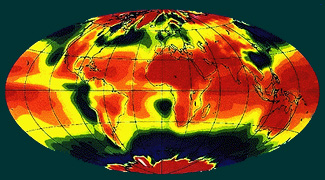


Annual average net radiation determined from 1985 to 1986. Net radiation is the difference between incoming solar radiation that is absorbed by Earth and outgoing infrared radiation from Earth that is lost to space. The net radiation is generally positive at low latitudes (increases in heating represented by oranges, reds, and pinks) and negative at high latitudes (increases in cooling represented by greens and blues). 
Annual average net cloud radiative forcing (bottom) determined from 1985 to 1986. Net cloud forcing is the result of two opposing effects: (1) greenhouse heating by clouds (or positive forcing)--clouds trap heat coming from Earth's surface that would otherwise be lost to space, and (2) cooling by clouds (or negative forcing)--clouds reflect incoming solar radiation back to space. The relatively large areas where cooling is the greatest are represented by colors that range from yellow to green to blue. In some areas, the effect of the clouds is to produce some warming as shown by colors that range from orange to red to pink. Overall, clouds have the effect of lessening the amount of heating that would otherwise be experienced at Earth's surface (Earth Radiation Budget Experiment data on the Earth Radiation Budget Satellite and the NOAA-9 satellite. Data processed at NASA Langley Research Center; images produced at the University of Washington). back: Deep Convective Clouds
|